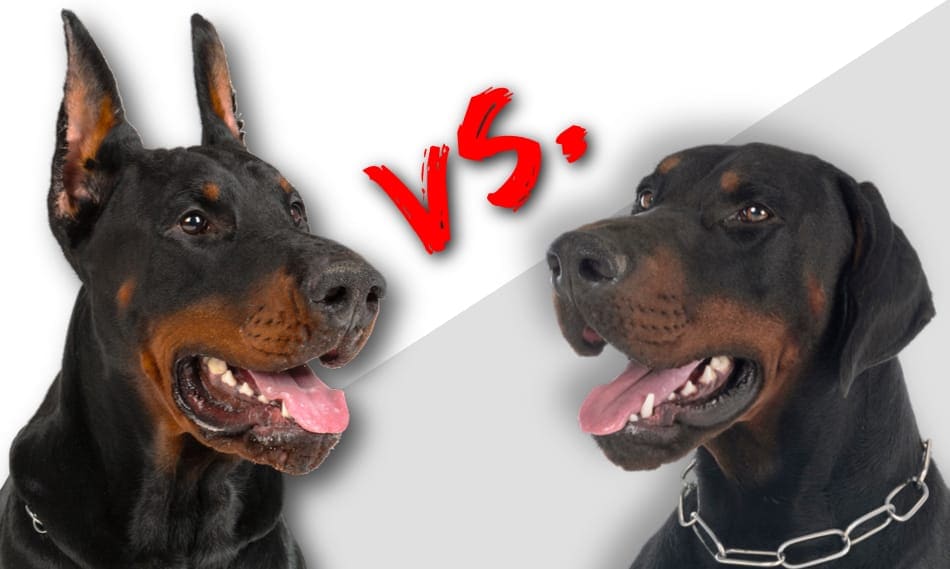Have you ever wondered why some Doberman dogs have cropped ears? The practice of cutting the ears of Doberman Pinschers is done for a variety of reasons, ranging from tradition to aesthetics to practicality. While it may seem unusual to alter a dog’s appearance in such a way, understanding the reasons behind this practice can provide insight into the world of dog breeding and ownership.
The decision to crop a Doberman’s ears has its roots in both history and practicality. Historically, ear cropping was done to reduce the risk of injury in certain working and hunting dog breeds. For Doberman Pinschers specifically, cropped ears were believed to enhance their alert appearance and give them a more intimidating presence, which can be advantageous in guarding and protection roles. While ear cropping is primarily a cosmetic procedure today, it is still legal and practiced by some owners and breeders. However, it is worth noting that the practice is becoming less common as attitudes towards cosmetic alterations of animals are changing and evolving.
Cropping the ears of Dobermans is a personal preference rooted in breed traditions. Historically, ear cropping was done for practical purposes, such as preventing ear injuries during work or combat. Today, some owners choose to crop for aesthetic reasons or breed conformity. However, ear cropping is a controversial practice and is banned in many countries due to animal welfare concerns. It is crucial to consult with veterinarians and consider all aspects before making a decision.

Why Do They Cut Doberman Ears?
Doberman pinschers are known for their sleek appearance and alert expression. One characteristic of Dobermans that often catches people’s attention is their cropped ears. But why do they cut Doberman ears? This practice, known as ear cropping, has been a subject of debate for years. In this article, we will explore the reasons behind ear cropping in Dobermans and the arguments for and against this controversial procedure.
The Historical Origins
Ear cropping in Dobermans has its roots in their historical origins. The Doberman pinscher breed was developed in Germany by a tax collector named Karl Friedrich Louis Dobermann in the late 19th century. Dobermans were initially bred as guard dogs and were used for purposes such as protecting their owners and apprehending criminals. The cropped ears were believed to add to their intimidating and streamlined appearance, making them more visually imposing.
Additionally, it was thought that cropped ears would offer some level of protection to the dog during confrontations, as the ear could be less susceptible to being bitten and injured. The historical context of Dobermans being working dogs meant that their physical appearance and functionality were crucial.
However, it is important to note that the popularity of ear cropping in Dobermans varies across different countries and regions. While it is more commonly seen in certain parts of the world like the United States, other countries have banned or significantly restricted the practice due to ethical concerns.
Aesthetic Reasons
One of the primary reasons why some people choose to crop their Doberman’s ears is for aesthetic purposes. The cropped ears are seen as a defining feature of the breed’s appearance and can enhance their distinct and sleek look. The Doberman pinscher is often portrayed in movies, TV shows, and other forms of media with cropped ears, further perpetuating the notion that this is the “ideal” look for the breed.
Proponents of ear cropping argue that it helps emphasize the dog’s alert expression and makes them appear more confident and assertive. The sleek, erect ears are believed to give the Doberman a more dignified and regal appearance. Some owners also prefer the cropped ears for practical reasons, such as reducing the risk of ear infections or keeping the ears cleaner and easier to maintain.
Breeder and Show Standards
Another reason for ear cropping in some Dobermans is adherence to breeder and show standards. In certain dog shows and competitions, Dobermans with cropped ears are preferred and have a better chance of winning. Breeders who specialize in producing show-quality Dobermans may choose to crop the ears of their puppies to meet these standards and enhance their chances of success in the show ring.
It is worth noting that breed standards and preferences may vary, and not all breeders insist on ear cropping. Some organizations, such as the American Kennel Club, now accept Dobermans with both cropped and natural ears in show competitions, recognizing that the decision to crop or not is a personal one for the dog owner.
Ethical Considerations and Growing Opposition
Despite the historical and aesthetic reasons behind ear cropping, the practice is becoming increasingly controversial. Many animal welfare organizations and veterinarians argue that ear cropping is unnecessary, painful, and ethically problematic. The procedure involves surgically removing a portion of the dog’s ear, which can cause pain, complications, and potential infections.
Opponents of ear cropping argue that a dog’s appearance should not be prioritized over their well-being and comfort. They believe that Dobermans, or any dog breed, should be appreciated and loved for their natural appearance, and ear cropping serves no significant purpose in modern society.
Legislation related to ear cropping varies across different countries and regions. Some countries, like the United Kingdom, have completely banned the procedure for non-medical reasons, whereas others have introduced stricter regulations or require the procedure to be performed by a licensed veterinarian. The debate continues, and public opinion is shifting towards discouraging ear cropping and promoting more humane and responsible practices.
Is Ear Cropping Necessary for Dobermans?
Ear cropping is a practice deeply rooted in the history and aesthetics of Doberman pinschers. However, as times change and perspectives evolve, the necessity of ear cropping has come into question. It is important to consider the ethical considerations, potential risks, and the well-being of the dog when making a decision about ear cropping.
The decision to crop or not crop a Doberman’s ears is ultimately up to the owner, taking into consideration local regulations and personal beliefs. It is essential to consult with a veterinarian and gather information from reputable sources before making a decision. Every Doberman is unique, and their appearance should not define their worth or quality of life.
Key Takeaways: Why Do They Cut Doberman Ears?
- Doberman ears are traditionally cut for cosmetic reasons.
- The process of ear cropping involves surgically altering the shape of the ear.
- Historically, ear cropping was done to enhance the Doberman’s appearance and to give them a more alert and intimidating look.
- Ear cropping is considered a controversial practice and is illegal or restricted in some countries.
- While some argue that cropped ears provide health benefits, research does not support these claims.
Frequently Asked Questions
Here are some common questions and answers about the practice of cutting Doberman ears:
1. Why do some people choose to have their Doberman’s ears cut?
There are different reasons why some people choose to have their Doberman’s ears cut. One reason is purely aesthetic. Cropped ears can give the Doberman a more alert and imposing appearance, which may appeal to some owners. Another reason is tradition. Ear cropping has been a practice for certain breeds, including Dobermans, for many years, and some owners may choose to continue the tradition.
From a practical standpoint, ear cropping may also help reduce the risk of certain ear infections. By removing most of the ear flap, there is less surface area for moisture, debris, and bacteria to accumulate, potentially decreasing the chances of developing ear infections. However, it’s important to note that the medical benefits of ear cropping are debated, and many veterinarians and animal welfare organizations oppose the practice.
2. Does ear cropping cause pain to the Doberman?
Ear cropping is typically performed when the Doberman is still a puppy, around 8 to 12 weeks of age. At this age, the puppy’s ear cartilage is still soft and pliable, making the procedure less painful. Local anesthesia or general anesthesia is administered to ensure the puppy is comfortable during the surgery. However, it’s important to note that like any surgical procedure, there will still be a period of recovery during which the Doberman may experience some discomfort.
Following the surgery, the Doberman’s ears will be taped and bandaged to help them heal in an upright position. The puppy may need to wear an Elizabethan collar to prevent them from scratching or damaging their ears. It’s crucial for owners to follow the veterinarian’s post-operative care instructions to ensure proper healing and reduce any potential pain or complications.
3. Are there any risks or complications associated with ear cropping?
As with any surgical procedure, there are risks and potential complications associated with ear cropping. These can include infection, delayed healing, excessive scarring, and anesthesia-related complications. It’s essential to choose a skilled and experienced veterinarian to perform the procedure to minimize these risks.
In addition, it’s important to consider that ear cropping is considered an elective procedure and not medically necessary. Some countries and jurisdictions have even banned the practice due to ethical concerns and welfare considerations. It’s crucial to research and consider both the risks and ethical implications before making a decision about ear cropping.
4. Can a Doberman’s ears be cropped after the puppy stage?
While it is possible to crop a Doberman’s ears after the puppy stage, it becomes more challenging as the puppy grows older. The cartilage in the ears becomes less pliable, increasing the risk of complications and affecting the final appearance. Additionally, the healing process may be more prolonged and uncomfortable for an adult Doberman.
If you are considering ear cropping for your Doberman, it is generally recommended to have the procedure done when the puppy is between 8 and 12 weeks of age. This allows for the best chance of successful healing and optimal cosmetic results.
5. Are there alternatives to ear cropping for achieving a certain look?
Yes, there are alternative ways to achieve a certain look without resorting to ear cropping. One option is to embrace the natural appearance of the Doberman’s ears without any modification. Many Doberman owners appreciate the breed’s unique characteristics, including their natural floppy ears.
If you desire a more alert appearance for your Doberman, there are also non-surgical alternatives available, such as the use of specially designed ear trainers or supports. These devices can help train the ears to be held upright, giving the Doberman a more alert and attentive look without the need for surgery.

Cropped Ears vs. Natural Ears: Which is Better?
People choose to cut the ears of Doberman dogs for various reasons, primarily to enhance their appearance and conform to breed standards. The practice of ear cropping involves surgically altering the shape of the ear to make it stand upright. It is often done when the puppy is young, around 7 to 12 weeks old, as the cartilage is still soft and malleable.
While ear cropping is a personal choice, it’s important to consider both the aesthetic and ethical aspects of the procedure. Supporters argue that cropped ears give Dobermans a more alert and fierce appearance. However, opponents argue that the procedure is unnecessary and can cause pain and complications for the dog. Ultimately, the decision to crop a Doberman’s ears should be made thoughtfully and take into account the well-being of the dog.
